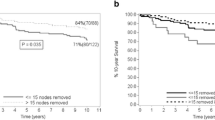The tumour-load in the axilla of breast cancer patients is classically measured from the number of tumour-bearing nodes present, which is then used to assess prognosis. This preliminary morphometric study on 73 cases of breast carcinoma for which standardized axillary dissection specimens were available shows that the total tumour load, measured from the sum of the tumour area (cm2) in hilar nodal sections, gives a redistribution of the patients; one that may provide better prognostic information in particular in women with a high tumour load. In those with four or more nodes involved the actual number is said to give little prognostic discrimination at 4 years post-operatively, as was demonstrated in this series. In contrast, using data from the same patients, the risk of death by this time increased steadily with increasing tumour area.
Similar content being viewed by others
References
Fisher B, Ravdin RG, Ausman RK, Slack NH, Moore GE, Noer RJ, et al., 1968, Surgical adjuvant chemotherapy in cancer of the breast: results of a decade of cooperative investigation. Annals of Surgery, 168, 337–356.
Hartveit F, Tangen M, Halvorsen JF, 1982, The axillary nodes and tumour size in breast cancer. Breast Cancer Research and Treatment, 2, 105–109.
Hartveit F, Tangen M, Halvorsen JF, Samsonsen G, 1985, Time-dependent changes in the axillary nodes in breast cancer: nodal area. Oncology, 42, 210–216.
Msuya CAD, 1989, Aspects of Metastasis in Breast Cancer. M Phil. Thesis. University of Bergen.
Hartveit F, 1990, Standardized axillary dissection: specimen weight and nodal content in breast cancer. Breast Cancer Research and Treatment, 17, 245–246.
Fisher B, Bauer M, Wickerman DL, Redmond CK, Fisher ER, 1983, Relation of number of positive axillary nodes to the prognosis of patients with primary breast cancer. An NSABP update. Cancer, 52, 1551–1557.
Pickren JW, 1961, Significance of occult metastases. A study of breast cancer. Cancer, 14, 1266–1271.
Huvos AG, Hutter RVP, Berg JW, 1971, Significance of axillary macrometastases and micrometastases in mammary cancer. Annals of Surgery, 173, 44–46.
Rosen PP, Saigo PE, Braun DW, Weathers E, Fracchia AA, Kinne DW, 1981, Axillary micro and macrometastases in breast cancer. Annals of Surgery, 194, 585–591.
Msuya CAD, Hartveit F, 1991, Skip lesions in the axilla in breast cancer, and their association with micrometastases. Breast Cancer Research and Treatment, 19, 277–281.
Hartveit F, 1984, The routine histological investigation of axillary lymph nodes in metastatic breast cancer. Journal of Pathology, 143, 187–191.
Fisher ER, Palekar A, Rockette H, Redmond C, Fisher B, 1978, Pathological findings from the national surgical adjuvant breast project (Protocol no. 4). Cancer, 42, 2032–2038.
Munro-Neville A, 1990, Are breast cancer axillary node micrometastases worth detecting? Journal of Pathology, 161, 283–284.
Author information
Authors and Affiliations
Rights and permissions
About this article
Cite this article
Hartveit, F., Msuya, C.A.D. Reassessment of tumour-load in the axilla in patients with breast cancer: a preliminary report. Clin Exp Metast 10, 121–124 (1992). https://doi.org/10.1007/BF00114588
Received:
Accepted:
Issue Date:
DOI: https://doi.org/10.1007/BF00114588




